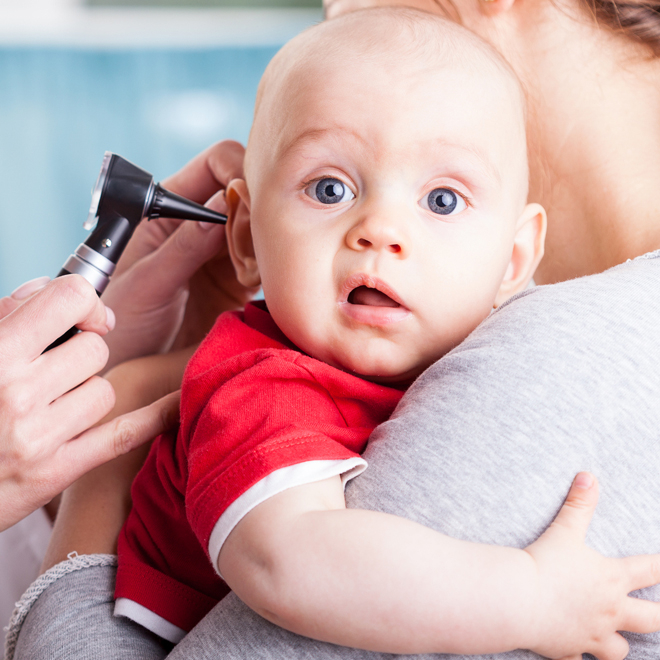Ear infections in babies can be a painful experience and many parents complain of sleepless nights. It is later realised that baby had an ear infection. Babies cannot communicate where pain is felt, it is better to check the symptoms of ear pain.
In This Article:
- A Guide for Ear Infection in Babies
- Common in Babies
- Causes of Ear Infection in Babies
- Symptoms of Ear Infection in Babies
- Diagnosis of Ear Infection in Babies
- Treatment for Ear Infection in Babies
- Prevent Ear Infection in Babies
- Home Remedies for Ear Infection in Babies
- When to Call the Doctor
A Guide for Ear Infection in Babies
Ear infection or otitis media is the infection of the middle ear which is usually caused by bacteria. The bacteria appear when fluid builds up behind the eardrum generally due to a blocked eustachian tube. Babies are more susceptible of getting an ear infection easily than adults. In fact, five out of six children will have atleast one ear infection before the age of three.
Common in Babies
The eustachian tube is one of the main components in maintaining balance in the body and is a gateway between the middle ear and throat. As the throat is moist, it is a breeding ground for bacteria. Any blockage in the eustachian tube can cause fluid build-up in the middle ear. As an infant’s tube is relatively small and narrow, it becomes very easy for bacteria to travel to the middle ear and lead to infection.
Causes of Ear Infection in Babies
The causes of ear infection in babies are –
- The infection is caused when bacteria infect the fluid build-up in the middle ear.
- Fluid gets accumulated in the middle ear due to a blocked eustachian tube.
- Eustachian tubes are blocked when the baby has cold, allergies or a sinus infection.
- Usage of a pacifier can increase the occurrence of otitis media in the baby by 33%.
Symptoms of Ear Infection in Babies
The signs and symptoms of ear infection in babies are –
- Tugging at the ear
- Nasal discharge
- Ear discharge
- Irritability and crankiness
- Disturbed sleep
- Fever
- Crying when lying down
- Loss of appetite
Diagnosis of Ear Infection in Babies
A diagnosis of an ear infection in babies can usually be made with just the symptoms alone but still, a proper testing will be done. The doctor initiates the test by asking about the baby child’s health of late. Otoscope is used, an instrument with a light attachment, to check for fluid behind the eardrum. Other methods used to check further for the infection –
- Pneumatic otoscopy
- Tympanometry
- Acoustic reflectometry
- Tympanocentesis
Treatment for Ear Infection in Babies
The treatment for ear infection in babies includes destroying the bacteria in the middle ear reducing the blockage of the eustachian tube and increasing the general immunity of the baby. Most doctors will hold off on prescribing antibiotics to treat the ear infection especially if it a mild infection. They will instead give the baby painkillers to manage the pain. If the infection continues to show no improvement or becomes more severe in the first 48 to 72 hours, then the doctor might put the baby on antibiotics.
Prevent Ear Infection in Babies
5 ways to prevent ear infection in babies are –
Breastfeeding
Breastfeed the baby for 6 to 12 months if possible. Antibodies in the milk can protect the baby from ear infections and a host of other medical conditions. These antibodies work only for the first six months.
Avoid Secondhand Smoke
Protect the baby from exposure to secondhand smoke which can make ear infections more severe and more frequent. Smoke suppresses the immune system of the baby and leaves open to bacterial infections that could cause an ear infection.
Proper Bottle Position
If feeding is done by the bottle, hold the baby in a semi-upright position so the formula doesn’t flow back into the Eustachian tubes. Avoid bottle propping for the same reason.
Healthy Environment
When possible, avoid exposing the baby to situations where cold and flu bangs around. Make sure to wash hands often to keep the germs away from the baby.
Vaccinations
Make sure the baby’s immunizations are up-to-date, including flu shots (for 6 months and older) and pneumococcal vaccines. Many of the infections that cause blockage of the eustachian tubes can be avoided with vaccinations. Consult the doctor about getting the annual flu shot to stop yearly infections of the flu and ear.
Also, identify the various allergies the baby may have especially the ones that affect the child’s respiratory system.
Home Remedies for Ear Infection in Babies
Some home remedies to help ease the pain are as follows –
- Warm compress
- Acetaminophen
- Warm oil
- Stay hydrated
- Elevate the baby’s head
- Massage
- Garlic/mullein drops
- Hydrogen peroxide
- Baking soda rinse
- Echinacea and goldenseal
- Chamomile oil to wash the infected ear
- Onions
- Saltwater
- Warm oil
When to Call the Doctor
Keeping the doctor posted in the first instance is imperative as not doing so can lead to more severe complications. It is best not to delay the right kind of medical attention the infection requires for the baby. The baby’s doctor will examine the eardrum with an otoscope. If the eardrum is red and bulging then it probably means that the baby has an ear infection.
Conclusion
Ear infections in babies are prevalent and painful which should be treated timely. It can be prevented. Contact the doctor for treatment to avoid complications.
Sources:
